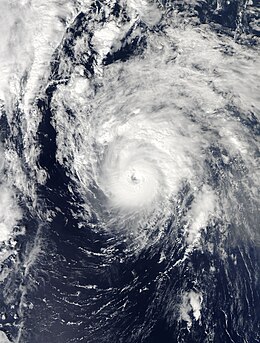Hurricane Ophelia (2011)
| Category 4 major hurricane (SSHWS/NWS) | |

Ophelia as a Category 3 hurricane on October 1
|
|
| Formed | September 19, 2011 |
|---|---|
| Dissipated | October 7, 2011 |
| (Extratropical after October 4, 2011) | |
| Highest winds |
1-minute sustained: 140 mph (220 km/h) |
| Lowest pressure | 940 mbar (hPa); 27.76 inHg |
| Fatalities | None |
| Damage | Minimal |
| Areas affected | Leeward Islands, Bermuda, Newfoundland |
| Part of the 2011 Atlantic hurricane season | |
Hurricane Ophelia was the most intense hurricane of the 2011 Atlantic hurricane season. The seventeenth tropical cyclone, sixteenth tropical storm, fifth hurricane, and third major hurricane, Ophelia originated in a tropical wave in the central Atlantic, forming approximately midway between the Cape Verde Islands and the Lesser Antilles on September 17. Tracking generally west-northwestward, Ophelia was upgraded to a tropical storm on September 21, and reached an initial peak of 65 mph (100 km/h) on September 22. As the storm entered a region of higher wind shear it began to weaken, and was subsequently downgraded to a remnant low on September 25. The following day, however, the remnants of the system began to reorganize as wind shear lessened, and on September 27, the National Hurricane Center once again began advisories on the system. Moving northward, Ophelia regained tropical storm status early on September 28, and rapidly deepened to attain its peak intensity with maximum sustained winds of 140 mph (220 km/h) several days later. The system weakened as it entered cooler sea surface temperatures and began a gradual transition to an extratropical cyclone, a process it completed by October 3.
Following the development of Ophelia, numerous storm watches and warnings were issued for the northeastern Caribbean Islands. Residents were urged to prepare for strong winds and substantial flooding. As the system made its closest approach, Ophelia produced several inches of rainfall, leading to mudslides and several road rescues. While light rain totals and gusty winds below tropical storm force were recorded on the island of Bermuda, storm surge and dangerous rip currents along the coast caused minimal damage. In Newfoundland, heavy rainfall contributed to floods that destroyed roads and many buildings. Following Ophelia's transition into an extratropical cyclone, residents across Europe were urged to prepare for strong winds in excess of 75 mph (120 km/h) in some locations, as well as rainfall accumulations up to 4 in (100 mm). In northern Ireland, a combination of moisture and significantly cooler weather produced several inches of snow across the region, cutting electricity to hundreds. Overall, there were no deaths reported in association with Ophelia, and damage was minimal.
...
Wikipedia
